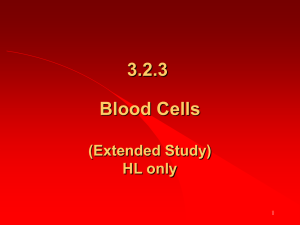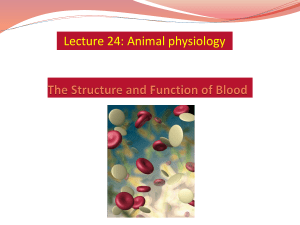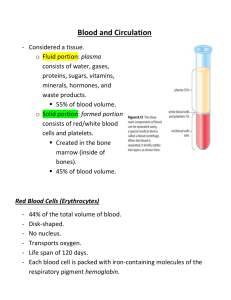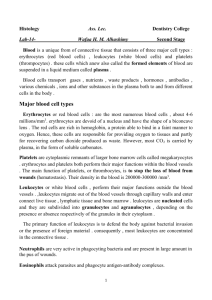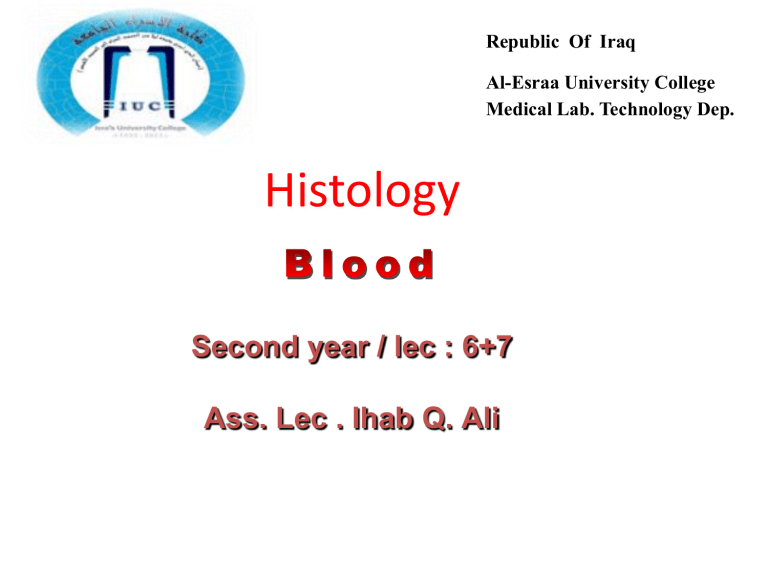
Republic Of Iraq Al-Esraa University College Medical Lab. Technology Dep. Histology Second year / lec : 6+7 Ass. Lec . Ihab Q. Ali Blood is a specialized body fluid in animals that delivers necessary substances such as nutrients and oxygen to the cells and transports metabolic waste products away from those same cells. Blood is a specialized connective tissue in which cells are suspended in fluid ECM called plasma. Propelled mainly by rhythmic contractions of the heart, about five liters of blood in an average adult moves unidirectional within the closed circulatory system formed elements circulating in the plasma are erythrocytes (red blood cells), leukocytes (white blood cells) and platelets Blood - Functions • Transports (Gases, Nutrients, Hormones) • Regulates pH & Electrolyte Balance in Interstitial Fluid • Prevents Fluid Loss from Bleeding • Defends against Pathogens & Toxins • Aids in Body Temperature Regulation Components - Plasma • Liquid Component of Blood • 92% Water • 7% Proteins: – Albumins (Most Abundant, Osmotic Pressure) – Globulins (Antibodies, Transport Proteins, Lipoproteins) – Fibrinogen (Clotting) • 1- 2% Inorganic Salts, Carbohydrates, Lipids, Hormones, Gases, Wastes, etc. Blood Cells Leukocyte Erythrocyte Agranulocyte Granulocyte 1-Monocyte 1-Neutrophile 2-Eosinophile 2-Lymphocyte 3-Basophile Thrombocyte Erythrocytes Erythrocytes (red blood cells) are lack nuclei, and are packed with the O2-carrying protein hemoglobin. Like most mammalian red blood cells, human erythrocyte are flexible biconcave disks . They are approximately 7.5µ m in diameter, 2.6µ m thick at the rim, and only 0.75µ m thick in the center. This biconcave shape provides a large surface-to-volume ratio and facilitates gas exchange. The normal concentration of erythrocytes in blood is approximately 3.9–5.5 million per microliter in women and 4.1–6 million per microliter in men. Fate of Erythrocytes Unable to divide, grow, or synthesize proteins Wear out in 100 to 120 days Removed by phagocytes in the spleen or liver New RBCs made by stem cells in bone marrow Erythrocyte Disorders Anemia (RBC or Hb Deficiency) Hemorrhagic (Blood Loss) Hemolytic (RBC Destruction) Aplastic ( Bone Marrow Function) Sickle Cell (Inherited Hb Mutation) Polycythemia (Abnormal in RBCs) Viscosity & B.P. with O2 Delivery Cyanosis, Blood Clots Leukocytes • Leukocytes (white blood cells) migrate to the tissues where they become functional and perform various activities . According to the type of cytoplasmic granules and the shape of their nuclei, leukocytes are divided into two groups: polymorphonuclear granulocytes and mononuclear agranulocytes. Both types are spherical while suspended in blood plasma, but become amoeboid and motile after leaving the blood vessels and invading the tissues. • Chemotaxis – Chemicals released from sites of damage or inflammation attract WBCs • Phagocytosis – ingestion of bacteria, debris Five Types Based on: • • • • Size Nuclear Shape Cytoplasmic Granules Affinity for Stain Granulocytes Neutrophils (Polymorphonuclear Leukocytes) • • Neutrophils constitute 60–70% of circulating leukocytes. They are 12–15 µ m in diameter in blood smears, with nuclei having two to five lobes linked by thin nuclear extensions . Neutrophils are inactive and spherical while circulating but become actively amoeboid during (diapedesis) The movement of white blood cells and other cells out of small arterioles,venules, and capillaris as part of the inflammatory response) diapedesis Eosinophil : Eosinophils are far less numerous than neutrophils, constituting only 2–4% of leukocytes in normal blood. Is about the same size as a neutrophil, but with a characteristic bilobed nucleus . The main identifying characteristic is the abundance of large, red specific granules that are stained by eosin. The major basic protein have cytotoxic effects on parasites such as helminthic worms and protozoa. They are an important source of the factors mediating allergic reactions and asthma. In tissues, eosinophils are found in the connective tissues underlying epithelia of the bronchi, gastrointestinal tract, uterus, and vagina, and surrounding any parasitic worms present . Basophils : Basophils are also about 12–15 µ m in diameter, but make up less than 1% , therefore difficult to find in smears of normal blood. The nucleus is divided into two or more irregular lobes, but the large specific granules overlying the nucleus usually obscure its shape. AGranulocytes Lymphocytes : Lymphocytes constitute a family of leukocytes with spherical nuclei . They can be subdivided into functional groups according to notably T lymphocytes, B lymphocytes, and natural killer (NK) cells. Lymphocytes have diverse functional roles related to immune defense against invading microorganisms, foreign or abnormal antigens, and cancer cells. Most lymphocytes in the blood are small with diameters of 6–8 µm; medium and large lymphocytes range in size from 9 to 18 µm in diameter. Monocytes: Monocytes are bone marrow–derived agranulocytes with diameters varying from 12 to 20µ m. The nucleus is large, and may be oval, kidney-shaped, or distinctly Ushaped. The chromatin is less condensed than in lymphocyt. The cytoplasm of the monocyte is basophilic and contains very small azurophilic granules (lysosomes).. In the electron microscope, nucleoli may be seen in the nucleus, and small mitochondria are observed. Circulating monocytes are precursor cells of the mononuclear phagocyte system . After crossing the walls of postcapillary venules, monocytes differentiate into macrophages in connective tissues, microglia in the CNS, osteoclasts in bone, etc. Platelets Blood platelets (thrombocytes) are nonnucleated, disklike cell fragments 2–4µ m in diameter. Platelets originate by fragmentation at the ends of cytoplasmic processes extending of cells called megakaryocytes in the bone marrow . Platelets 1- promote blood clotting and 2- help repair minor tears or leaks in the walls of blood vessels, preventing loss of blood. Normal platelet counts range from 200,000 to 400,000 per microliter of blood. Platelets have a life span of about 10 days. In stained blood smears, platelets often appear in clumps. Pluripotent Hemopoietic Stem Cells It is believed that all blood cells arise from a single type of stem cell in the bone marrow called a pluripotent stem cell because it can produce all blood cell type. The pluripotent stem cells proliferate and form two major cell lineages: one for lymphoid cells (lymphocytes) and another for myeloid cells that develop in bone marrow. Myeloid cells include granulocytes,monocytes, erythrocytes, and megakaryocytes. Early in their development, lymphoid cells migrate from the bone marrow to the thymus or to the lymph nodes, spleen, and other lymphoid structures, where they proliferate and differentiate . Bone Marrow Under normal conditions, the production of blood cells by the bone marrow is adjusted to the body's needs, increasing its activity several-fold in a very short time. Bone marrow and adipocytes are found in the medullary canals of long bones and in the cavities of cancellous bones. There are two types of bone marrow based on their appearance at gross examination: bloodforming red bone marrow, whose color is produced by an abundance of blood and hemopoietic cells, and yellow bone marrow, which is filled with adipocytes and essentially excludes hemopoietic cells. In the newborn, all bone marrow is red and active in blood cell production, but as the child grows most of the marrow changes gradually to the yellow variety. Under certain conditions, such as severe bleeding or hypoxia, yellow marrow reverts to red.
